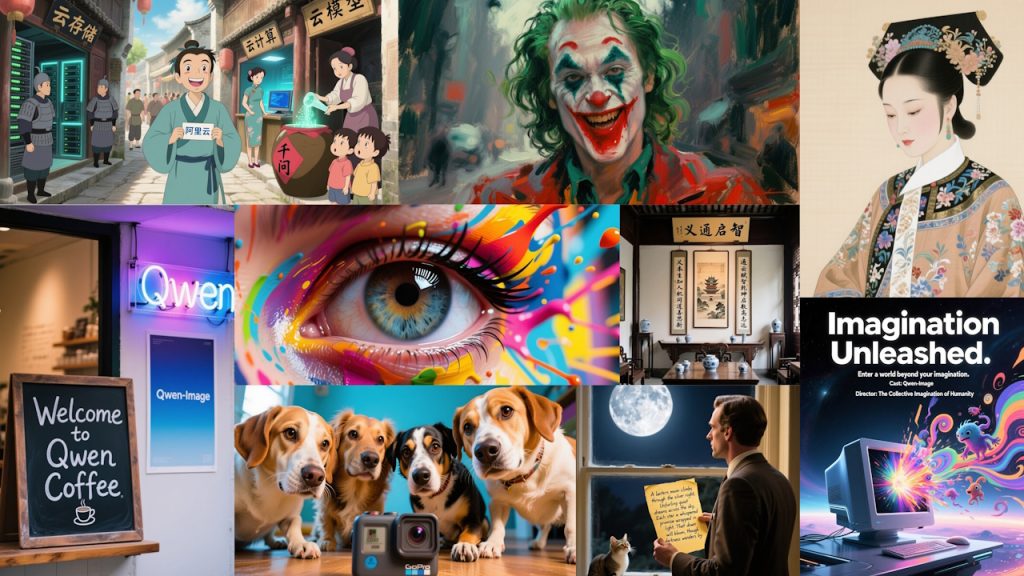Chinese tech giant Alibaba has escalated the AI image generation race, releasing a powerful new open-source model on August 4 that excels at one of the toughest challenges for AI: accurately rendering text.
Available globally on platforms like Hugging Face, Qwen-Image demonstrates a state-of-the-art ability to generate complex text, including multi-line Chinese characters, directly within high-fidelity images.
Released under a permissive Apache 2.0 license, the model directly challenges proprietary Western systems from Google and OpenAI. It aims to provide developers with a free, powerful alternative that seamlessly integrates intricate text with visual creation, a long-standing hurdle for generative models.
A New Benchmark for Text in AI Imagery
At its core, Qwen-Image is a 20-billion parameter foundation model built upon a Multimodal Diffusion Transformer (MMDiT) architecture. To interpret complex user prompts, it leverages a frozen Qwen2.5-VL vision-language model as its condition encoder, a design choice that capitalizes on a model already adept at aligning language and visual data.
This powerful architecture is supported by what the Qwen team describes in its technical report as a comprehensive data pipeline and a progressive training strategy. The model was trained using a “curriculum learning” approach, starting with basic non-text rendering before gradually scaling to handle complex, paragraph-level descriptions.
This method was crucial for enhancing its native text rendering abilities, particularly for challenging logographic languages like Chinese. To further improve its handling of rare characters and diverse fonts, the team developed a multi-stage data synthesis pipeline to generate high-quality, text-rich training images.
A key innovation for image editing is the model’s dual-encoding mechanism. To make a change, the system processes the input image in two ways: Qwen2.5-VL extracts high-level semantic features, while a Variational Autoencoder (VAE) captures low-level reconstructive details, as detailed in the official technical report.
Both sets of features are fed into the MMDiT, enabling the model to strike a precise balance between maintaining semantic consistency and preserving visual fidelity. The VAE itself was specially fine-tuned on a corpus of text-heavy documents like PDFs and posters to sharpen its reconstruction of fine details and small text.
On public benchmarks, this sophisticated approach has established Qwen-Image as a top-tier performer. It excels on text-focused evaluations like LongText-Bench and the new ChineseWord benchmark, outperforming existing models by what its creators call a “significant margin”. This performance positions it as a powerful open-source challenger to leading proprietary systems.
Beyond Text: A Versatile Creative Engine
While its text rendering is a standout feature, Qwen-Image is a versatile and powerful tool for general-purpose image generation. The model demonstrates strong cross-benchmark performance, supporting a wide range of artistic styles. As showcased in its official announcement, it can fluidly adapt to creative prompts, producing everything from photorealistic scenes and impressionist paintings to anime aesthetics and minimalist designs.
Its editing capabilities are equally robust, enabling advanced operations that go far beyond simple adjustments. The technical report shows the model adeptly handling style transfers, object insertion or removal, and even complex human pose manipulation. In qualitative comparisons, Qwen-Image successfully preserves fine details like hair strands during pose changes and correctly infers clothing details that were previously obscured, demonstrating a sophisticated understanding of context.
Perhaps its most forward-looking feature is the application of its generative power to tasks typically handled by specialized computer vision models. The Qwen team demonstrates that the model can perform a suite of image understanding tasks through simple editing prompts. These include object detection, semantic segmentation, depth and edge (Canny) estimation, and novel view synthesis. By framing these perception tasks as forms of intelligent image editing, Alibaba is effectively bridging the gap between AI that sees the world and AI that creates it.
Part of a Broader Open-Source Offensive
The Qwen-Image launch is not an isolated event. It is the latest move in a rapid-fire series of major AI releases from Alibaba, signaling a comprehensive strategy to build a full suite of open tools for developers and dominate the open-source ecosystem.
In the preceding weeks, the company unveiled a new flagship reasoning model, Qwen3-Thinking-2507, which topped key industry benchmarks against rivals like Google and OpenAI. This was accompanied by a powerful agentic coding model, Qwen3-Coder.
This strategic pivot was underscored by a statement from Alibaba Cloud, which explained its decision to abandon the “hybrid thinking” mode of earlier models. A spokesperson said, “after discussing with the community and reflecting on the matter, we have decided to abandon the hybrid thinking mode. We will now train the Instruct and Thinking models separately to achieve the best possible quality,” clarifying the new focus on specialized, high-quality systems.
The company also recently launched Wan2.2, a major open-source update to its AI video generation models. That release introduced an advanced Mixture-of-Experts (MoE) architecture to improve video quality and efficiency.
Navigating a Contentious AI Landscape
This aggressive push comes as the industry grapples with growing skepticism about the reliability of AI benchmarks. Just weeks ago, a study alleged that Alibaba’s older Qwen2.5 model had “cheated” on a key math test by memorizing answers from contaminated training data.
The controversy highlights a systemic issue of “teaching to the test” in the race for leaderboard dominance. As AI strategist Nate Jones noted, “the moment we set leaderboard dominance as the goal, we risk creating models that excel in trivial exercises and flounder when facing reality.” This sentiment is echoed by experts like Sara Hooker, Head of Cohere Labs, who argued that “when a leaderboard is important to a whole ecosystem, the incentives are aligned for it to be gamed.”
By focusing on a tangible, difficult capability like text rendering, Alibaba appears to be shifting the narrative from abstract leaderboard scores to real-world utility and open innovation.
This strategy of providing powerful, free alternatives directly challenges the closed, proprietary models that dominate the high end of the market. It escalates competition and reflects a bet that an open ecosystem will foster faster innovation and wider adoption.

